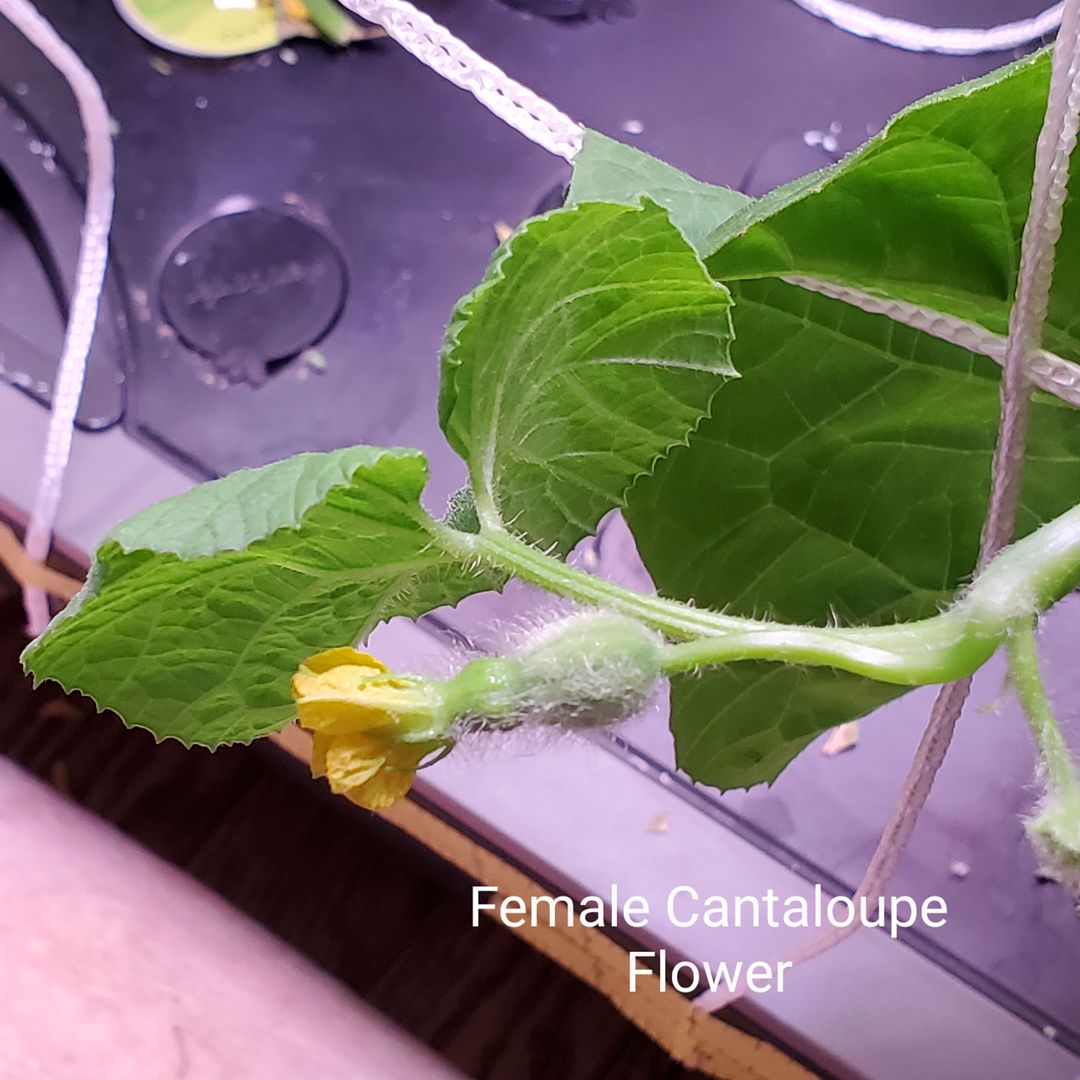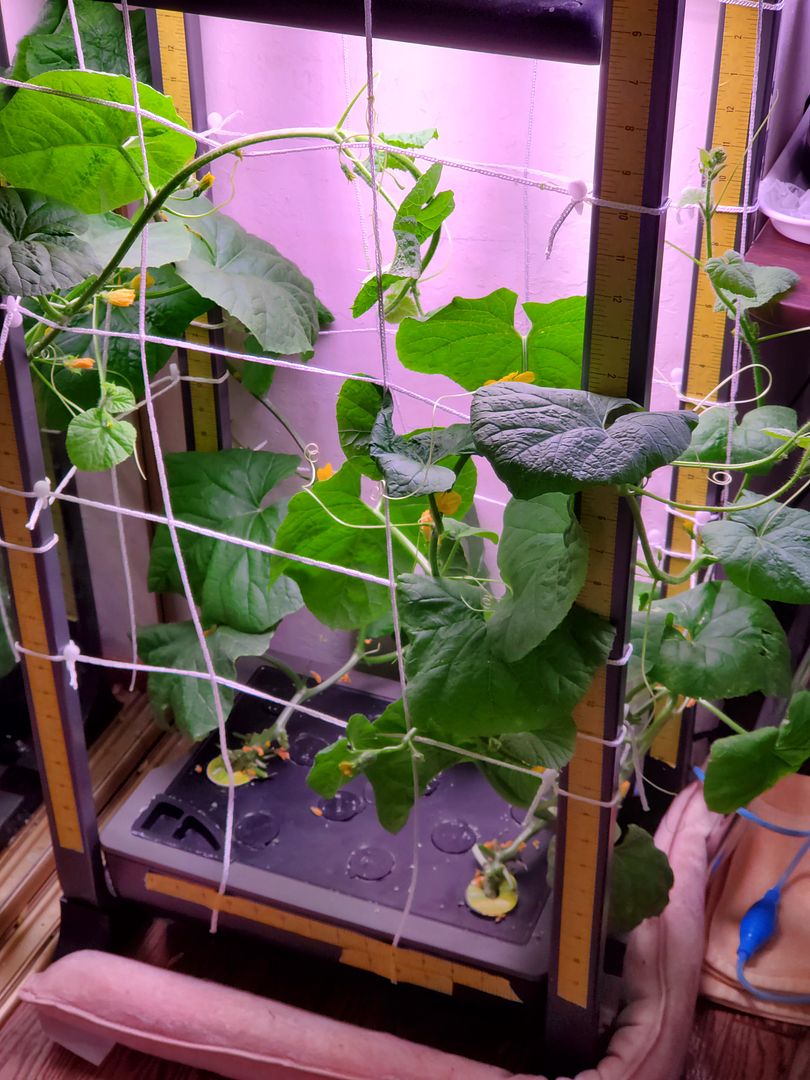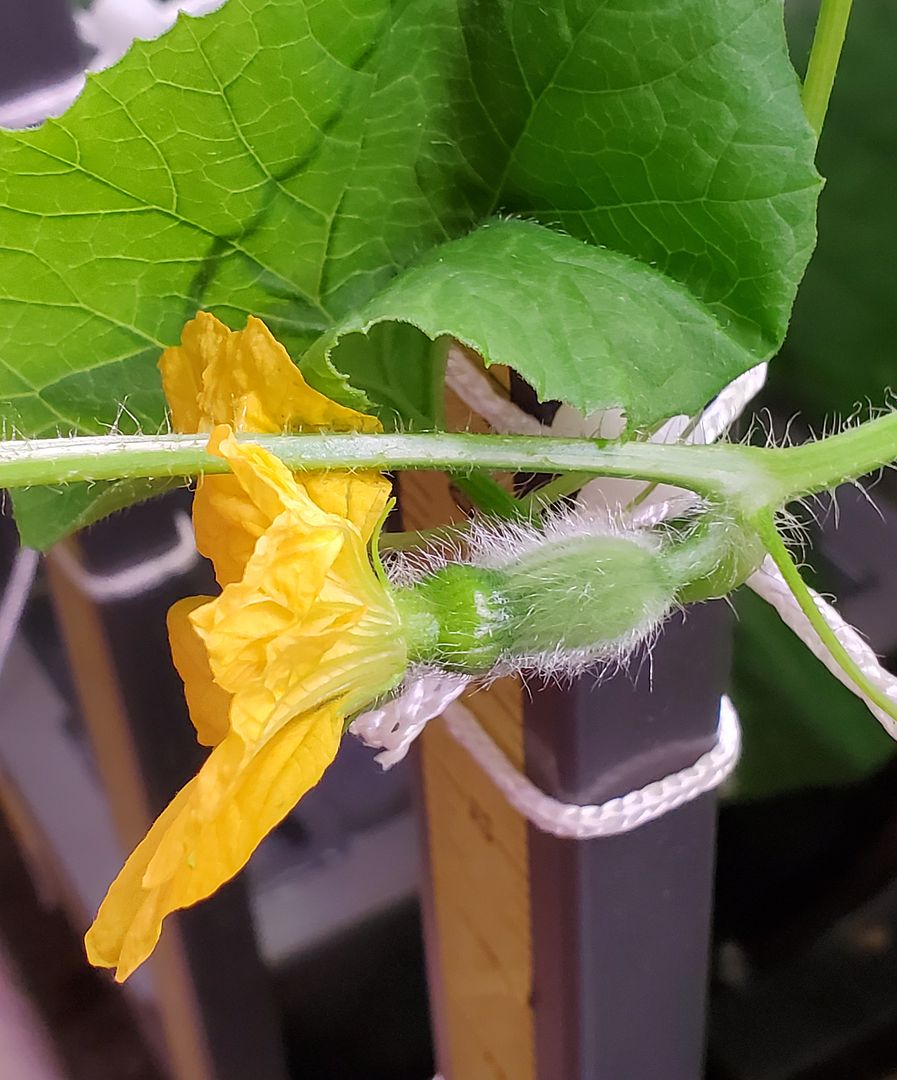|
|
Post by scarfguy on May 7, 2023 11:38:31 GMT -5
If I remember correctly, it took quite awhile for the female flowers to show up...
Pollination I found to be a bit difficult. The pollen is a sticky clump. It's not a loose powder like most plants. Probably cause it has to stick onto the bee to get transferred. You have to push it onto the female flower gently. If you push too hard, I think you damage to female receptor. You really can't tell if your efforts are successful until a couple of days have past.
|
|
|
|
Post by lynnee on May 7, 2023 18:18:14 GMT -5
Well, I lied. Finally a female flower on one main Vine! Either it hasn't opened yet, or I'm too late for pollination. But I got a picture!  Today I removed all the lateral vines, because they were making it too hard to check the flowers. I also removed the main vine on the left (by mistake), but it had a vigorous lateral that can take over (I hope). There were lots and lots of male flowers on the lateral vines.  |
|
|
|
Post by scarfguy on May 7, 2023 18:40:03 GMT -5
Yup! That female flower hasn't opened yet. Prepare to pollinate! (tomorrow or tuesday).
Because you don't know if you pollinated the flower or pollinated it at the right time, I found myself using too many male flowers. I reached a point where I had a bunch of female flowers opening at the same time and I had no male flowers left. SO... you have to pollinate frequently but keep an eye on your supply of developing male flowers.  |
|
|
|
Post by lynnee on May 9, 2023 13:57:52 GMT -5
If I remember correctly, it took quite awhile for the female flowers to show up... Pollination I found to be a bit difficult. The pollen is a sticky clump. It's not a loose powder like most plants. Probably cause it has to stick onto the bee to get transferred. You have to push it onto the female flower gently. If you push too hard, I think you damage to female receptor. You really can't tell if your efforts are successful until a couple of days have past.
What does the sticky clump look like? On my male flowers, if you remove the petals as suggested by various Internet cantaloupe pollinators, you see a green extension surrounded by yellow spiky things. Is it the yellow part that has the pollen?  |
|
|
|
Post by scarfguy on May 9, 2023 14:13:54 GMT -5
Yes, the yellow spikey things are the pollen. I just pushed the yellow part into the center of the female flower. If you push too softly, the pollen doesn't transfer and if you push too hard, I think you damage the flower. If you smush he spikey things, I think you can see the individual pollen grains.
|
|
|
|
Post by lynnee on May 10, 2023 18:54:42 GMT -5
scarfguy, Could this one be a bisexual cantaloupe flower? It has a yellow center, with a little melon behind it. I'm going to leave it unpollinated, because bisexual flowers don't need pollination, to see what happens. I'm still waiting to see whether my first two attempts at pollination worked. The flowers are withering, but haven't dropped yet. The two vines have a lot of male flowers again.   
|
|
|
|
Post by scarfguy on May 10, 2023 19:42:03 GMT -5
I don't know. 
Just looks like a female flower to me.
|
|
|
|
Post by lynnee on May 18, 2023 11:53:15 GMT -5
So far, I haven't managed to pollinate any female flowers, but there are three now that I have high hopes for. At least I've learned that pollination didn't take if the little bulges behind the flower change to a yellow shade. The unpollinated female flowers take a long time to drop off!  |
|
|
|
Post by lynnee on May 18, 2023 11:55:18 GMT -5
I don't know.  Just looks like a female flower to me.
You are right, I think. This one didn't do anything.  |
|
|
|
Post by scarfguy on May 18, 2023 12:12:19 GMT -5
So far, I haven't managed to pollinate any female flowers, but there are three now that I have high hopes for. At least I've learned that pollination didn't take if the little bulges behind the flower change to a yellow shade. The unpollinated female flowers take a long time to drop off! 
Yes, unpollinated female flowers turn yellow and slowly shrink. You will notice when you are successful. Within a day or two the bulge at the back of the flower will swell and turn dark green rather quickly.
I think timing is important although I don't know what the right timing is. I was most successful when I attempted to pollinate a flower from the day it first open and again for the next 2 or 3 days. Of course, that is why I ran out of male flowers.
|
|
|
|
Post by lynnee on May 18, 2023 15:31:58 GMT -5
Something I read said that the female and male flowers were only good for 1 day. So I'm trying to use fresh male flowers when the females open.  |
|
|
|
Post by scarfguy on May 18, 2023 15:51:18 GMT -5
Yup, that's what I was doing. I took a fresh male flower and touched it to 2 or 3 female flowers in the hopes that one of them was receptive.
ALSO, I didn't get any pollination at first. My vines got about 3 feet long before I had my first successful pollination. SO... I don't know if my technique improved or if the plant needs to be somewhat mature in order to produce viable flowers.
|
|
|
|
Post by lynnee on May 18, 2023 17:24:28 GMT -5
One female flower looks very promising today. Swollen a little, and still green after the flower has closed for a few days.  |
|
|
|
Post by scarfguy on May 21, 2023 15:49:56 GMT -5
I planted a cantaloupe called "Hearts of Gold". ...
The other melon is "Petit Gris de Rennes", a typical European melon from France. ...
UPDATE: The rather traditional cantaloupe (muskmelon) called "Hearts of gold" germinated and is now a little seedling. yeah! 
The Petit Gris de Rennes did not germinate. 
SO.... I had a variety of seeds (I buy interesting seeds and decide later what I want to plant) and decided to plant a variety and see which one germinates first! ...
And the winner is: a Kajari melon. This is an Indian melon from the punjab region. It is a lovely small melon with multiple colored smooth skin. Gourd-like in appearance.
Hopefully they will both grow to maturity!
|
|
|
|
Post by lynnee on May 22, 2023 12:22:07 GMT -5
Still no luck in pollinating the cantaloupe female flowers. I have two that look promising, but they are both on the same lateral at the same node. I wonder whether two cantaloupes can mature so close to each other? Yesterday I removed the second cantaloupe plant from the Farm XL12. Turns out that the vine hadn't done much after I inadvertently pruned the growing tip--the lateral did NOT take over as hoped.  EDIT: One of the two cantaloupe hopefuls is starting to yellow, so I don't think the pollination "took". Unless the other one shows signs of developing in the next day or two, I'm going to end the midget cantaloupes. There are no more female flowers on the vine, and I want to start some flowers for transplanting outdoors. |
|
|
|
Post by lynnee on May 23, 2023 20:26:28 GMT -5
Today I ended the second cantaloupe project, with one healthy vine, two more failed pollination attempts, and nothing but male flowers. Probably I'll try cantaloupes again, but they need extra attention, and I'm short of hobby time right now.  I still have two indeterminate tomatoes growing in a Farm, and two more growing outdoors. That's enough vines! The Farm has been cleaned, and I'll start some flowers soon. |
|
|
|
Post by scarfguy on May 23, 2023 20:53:54 GMT -5
Sorry to hear of your failure...
Yes, cantaloupe took a lot of my time. I probably attempted to pollinated about 75 flowers and only got 5 melons.
I'm trying to grow two this time so, hopefully, I will gain some more experience with hand pollination that I will share.
Good luck with the indeterminate tomatoes.
I just started two also. (a san marzano and a golden roma)
|
|
|
|
Post by lynnee on May 24, 2023 9:02:58 GMT -5
Tomatoes are easy, scarfguy, but the indeterminate vines are something of a challenge. (Just shake tomatoes to pollinate, or buzz them with an electric toothbrush to increase production.) Keep us posted on your indeterminates, please!  |
|
|
|
Post by scarfguy on Jun 18, 2023 10:52:18 GMT -5
SO...continuing the melon saga...
I've been having a terrible time getting my melon seeds to germinate successfully. They all sprout quickly but then get leggy with weak stems and fall over. Early on, I got this Indian Kajari melon to strengthen with a small toothpick stake and it eventually took off. So far, the other bounty has a Galia melon that is a small 4 leaf seedling but it seems to be growing strong. We'll see...
Interestingly, although the Kajari is now big enough to sprout male flowers, IT HAS NO TENDRILS! None of the nodes have sprouted tendrils. I don't know if it needs to be a bit more mature or if this variety doesn't have any. I should be able to tie it to the trellis without tendrils but I've never heard of such a thing.
Searching the internet for answers, I've only found one reference that mentioned some small-sized melons sometimes don't have tendrils. None of the descriptions of Kajari melons mention this.
If anybody can shed light on this phenomenon, I would appreciate it.
|
|
|
|
Post by scarfguy on Jun 25, 2023 18:21:15 GMT -5
UPDATE!
NEVERMIND... 
The Kajari melon finally started producing tendrils! and they are profuse and strong. It's grabbing onto everything.
Lots of male flowers. So far, no female flowers.
The sprout beside the Kajari is a Galia melon. It's not growing very fast but it seems to be healthy.
|
|